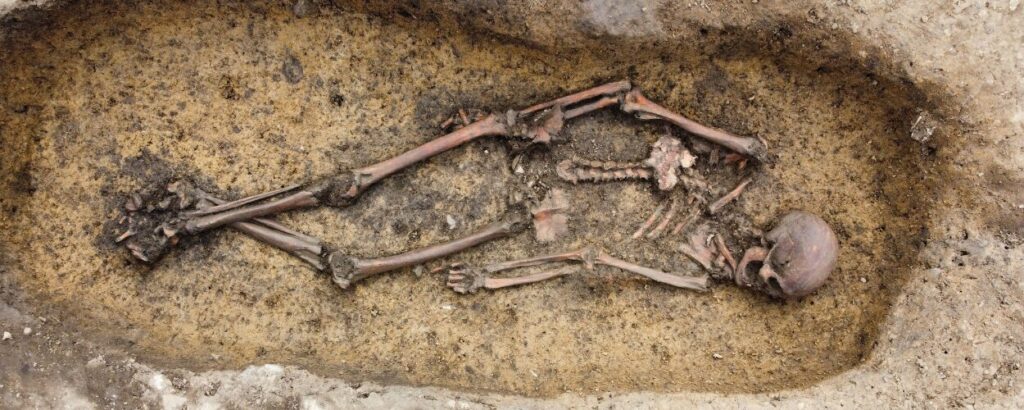Archaeologists from Museum Odense have uncovered over 50 remarkably well-preserved Viking skeletons in Åsum, a village in southern Denmark. The discovery, which includes artifacts from far beyond Denmark’s borders, highlights the Vikings’ extensive trade networks and offers a unique opportunity to learn more about their lives during the 9th and 10th centuries.
The excavation, conducted earlier this year, unearthed one of the largest Viking burial sites on the island of Funen, covering approximately 2,000 square meters. The burial ground, believed to date back to the reign of Gorm the Old in the mid-10th century, includes 50 inhumation graves and five cremation graves.
“It is truly unusual to find so many well-preserved skeletons at once, like those discovered in Åsum,” said Michael Borre Lundø, archaeologist and curator at Museum Odense. “This discovery offers extraordinary opportunities to perform a wide range of scientific analyses, which can reveal more about the general health, diet, and origins of those buried. The analyses might even reveal whether the buried Vikings were related, which would be particularly significant, as this has never been examined in similar graves.”
The exceptional state of preservation opens the door to advanced research, including ancient DNA (aDNA) analysis. According to Sarah Croix, associate professor at Aarhus University, this is a groundbreaking opportunity.
“The graves in Åsum are so well-preserved that it may be possible, for the first time, to conduct special aDNA analyses on most of the skeletons—meaning DNA analyses on ancient material,” Croix explained. “It will be incredibly exciting to learn where these people came from and whether the same families were buried here across multiple generations.”
High-Status Burials and International Connections
Some of the graves indicate the individuals buried were of high social status, as evidenced by their grave goods. Among the most striking finds is a woman buried in a wagon, an upper part of a Viking cart used as a coffin. Her grave contained a glass bead necklace, an iron key, a knife with a silver-threaded handle, and a shard of glass that may have been an amulet. A finely decorated wooden chest was also found at the foot of the wagon.
“The woman was buried in the wagon she likely traveled in,” Lundø noted. “We must imagine that she was buried with her finest clothes and belongings. She was given a beautiful glass bead necklace, an iron key, a knife with a silver-threaded handle, and, most notably, a small shard of glass that may have served as an amulet. At the foot of the wagon, there was a finely decorated wooden chest, the contents of which we still do not know.”
Another grave contained items such as a three-lobed bronze brooch, a red glass bead, an iron knife, and a piece of imported rock crystal, likely sourced from Norway. These artifacts underscore the Vikings’ role in international trade networks during the Viking Age.
Åsum: A Viking Hub
The burial ground confirms Åsum’s importance as a settlement during the Viking Age, situated near the early urban center of Odense, historically known as Odins Vi.
“It’s fascinating to imagine that the buried Vikings were undoubtedly aware of the nascent urban development that took place just five kilometers west of where they lived,” Lundø said. “Their descendants witnessed the cementing of Odense as a town, while Harald Bluetooth constructed one of his ring forts—Nonnebakken—south of the river as part of his effort to unify the kingdom.”
The excavation was conducted in preparation for renovations of an electrical grid. The findings place Åsum among the key geographical points in the early urban development of what became Odense, shedding light on the lives and connections of the Vikings who lived there. As researchers continue to analyse the site, this remarkable discovery promises to expand our understanding of Viking society, trade, and family structures.
Subscribe to Medievalverse


